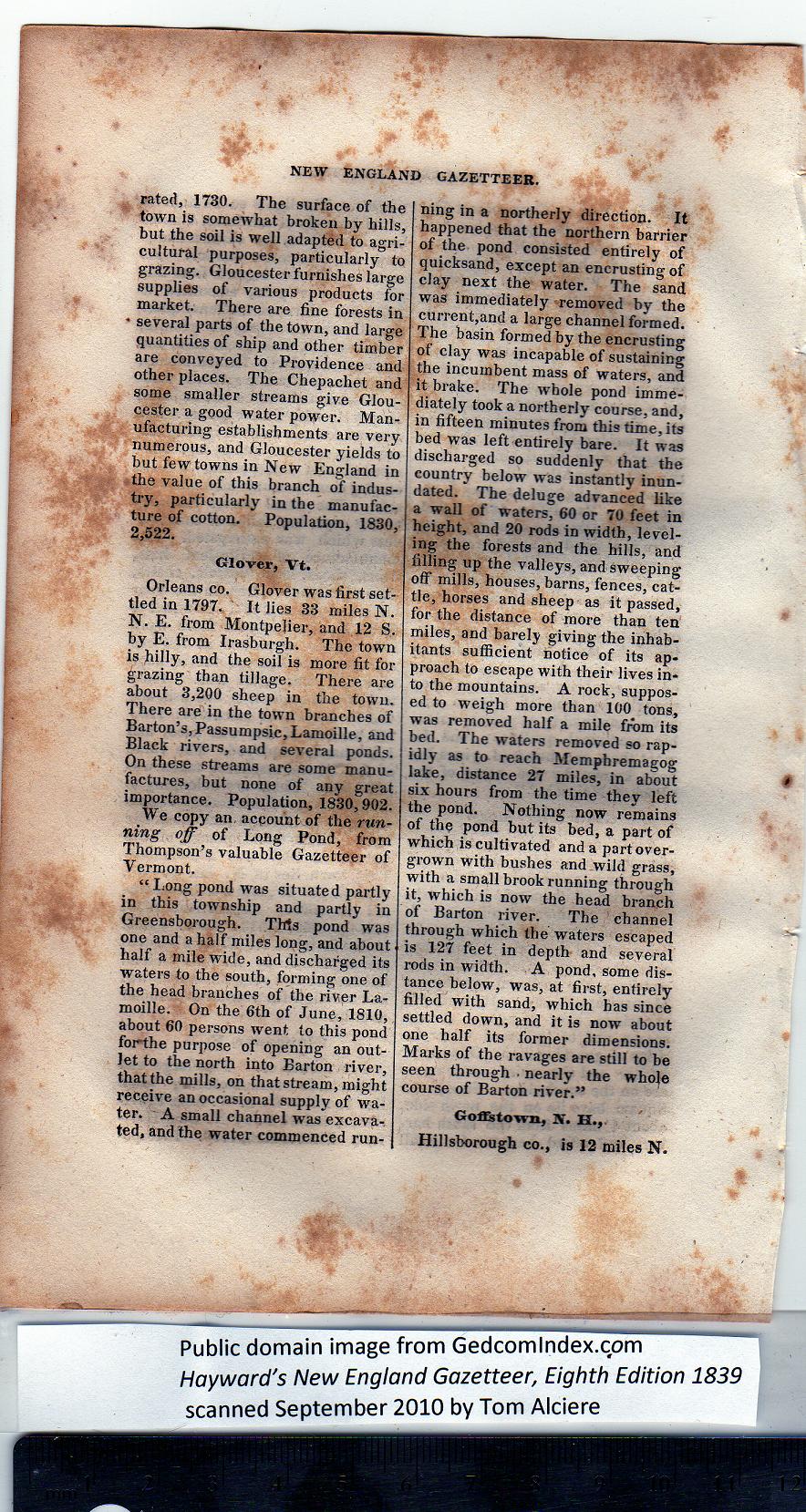|
rated, 1730. The surface of the
town is somewhat broken by hills,
hut the soil is well adapted to agri-
cultural purposes, particularly to
grazing. Gloucester furnishes large
supplies of various products for
market. There are fine forests in
several parts of the town, and large
quantities of ship and other timber
are conveyed to Providence and
other places. The Chepachet and
some smaller streams give Glou-
cester a good water power. Man-
ufacturing establishments are very
numerous, and Gloucester yields to
but few towns in New England in
the value of this branch of indus-
try, particularly in the manufac-
ture of cotton. Population, 1830,
2,522.
Glover, Vt.
Orleans co. Glover was first set-
tled in 1797. It lies 33 miles N.
N. E. from Montpelier, and 12 S.
by E. from Irasburgh. The town
is hilly, and the soil is more fit for
grazing than tillage. There are
about 3,200 sheep in the town.
There are in the town branches of
Barton’s, Passumpsic, Lamoille, and
Black rivers, and several ponds.
On these streams are some manu-
factures, but none of any great
importance. Population, 1830,902.
We copy an account of the run-
ning off of Long Pond, from
Thompson’s valuable Gazetteer of
Vermont. |
“Long pond was situated partly
in this township and partly in
Greensborough. This pond was
one and a half miles long, and about
half a mile wide, and discharged its
waters to the south, forming one of
the head branches of the river La-
moille. On the 6th of June, 1810,
about 60 persons went to this pond
forthe purpose of opening an out-
let to the north into Barton river,
that the mills, on that stream, might
receive an occasional supply of wa-
ter. A small channel was excava-
ted, and the water commenced run-
ning in a northerly direction. It
happened that the northern barrier
of the pond consisted entirely of
quicksand, except an encrusting of
clay next the water. The sand
was immediately removed by the
current,and a large channel formed.
The basin formed by the encrusting
of clay was incapable of sustaining
the incumbent mass of waters, and
it brake. The whole pond imme-
diately took a northerly course, and,
in fifteen minutes from this time, its
bed was left entirely bare. It was
discharged so suddenly that the
country below was instantly inun-
dated. The deluge advanced like
a wall of waters, 60 or 70 feet in
height, and 20 rods in width, level-
ing the forests and the hills, and
filling up the valleys, and sweeping
off mills, houses, barns, fences, cat-
tle, horses and sheep as it passed,
for the distance of more than ten
miles, and barely giving the inhab-
itants sufficient notice of its ap-
proach to escape with their lives in-
to the mountains. A rock, suppos-
ed to weigh more than 100 tons,
was removed half a mile from its
bed. The waters removed so rap-
! idly as to reach Mempbretnagog
lake, distance 27 miles, in about
six hours from the time they left
the pond. Nothing now remains
of the pond but its bed, a part of
which is cultivated and a part over-
grown with bushes and wild grass,
with a small brook running through
it, which is now the head branch
of Barton river. The channel
through which the waters escaped
is 127 feet in depth and several
rods in width. A pond, some dis-
tance below, was, at first, entirely
filled with sand, which has since
settled down, and it is now about
one half its former dimensions.
Marks of the ravages are still to be
seen through • nearly the whole
course of Barton river.”
Goflstown, X. H»,
Hillsborough co., is 12 miles N. |
